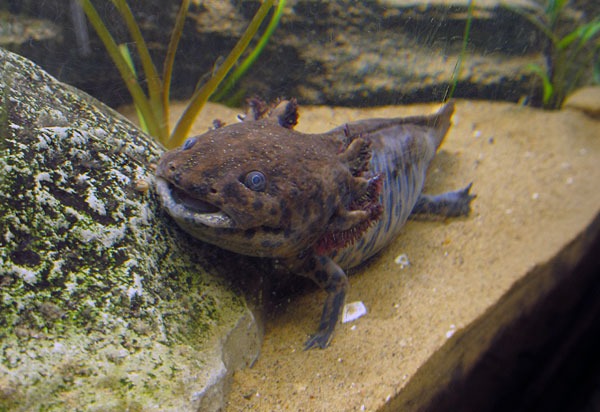Our Latest Residents Make Malton, Rather Than Mexico, Their Home!

We’re delighted to welcome three Anderson’s Salamanders (Ambystoma andersoni) to our animal collection and can report that they have settled in well to their new home far from their native residence of Mexico.
The trio can be viewed in their habitat in the aquarium and we’re so excited to have them here, not only because of their unique looks, but also as there is still so much to learn about them as they were only discovered 1984!
They are endemic to only one lake in the Mesa Central portion of Mexico (Lake Zacapu) and this salamander is found in an area as little as 19km2. With such a small home range and the entire wild population located in a single body of water, this species is highly susceptible to threats in their environment decreasing their numbers further; and therefore is classed as a Critically Endangered species on the IUCN Red List.
At first glance the Anderson’s Salamander may be mistaken for an Axolotl as they have similar body shapes and external feathery gills; however, when the two amphibians are compared, their differences are much more apparent. Both animals belong to the amphibian family Ambystomatidae, which are admired by scientists for their neotenous (retaining juvenile characteristics) life history.
These salamanders not only spend the majority of their lives in an undeveloped larval form, but they achieve reproductive maturity within this juvenile stage. This is like the equivalent of a tadpole remaining as a tadpole, being able to breed but never forming in to a frog. These salamanders don’t metamorphose in to their adult stage, and so keep their gills throughout their lives. Being able to live in the cool and clean waters is not just safer, but as plenty of snails and crawfish to eat, the salamanders have everything they need to survive without needing to venture on to land.
Whilst this is advantageous, disadvantages have also sprung up with the decline of the extent and quality of Lake Zacapu. Local people use the lake as a food source, and have exploited and polluted the environment as a result. In addition to this, introduced fish species to the lake pose a predatory threat to the Critically Endangered amphibians.
The salamanders and the lake has Special Protection by the Government of Mexico to avoid further losses; however this ecosystem is in need of further conservation efforts relating to water and land management as well as the control of the introduced predatory fish in order to keep the species from becoming extinct in the wild. We are very proud to play our part in the important role of conservation through strategically planned breeding programmes.


